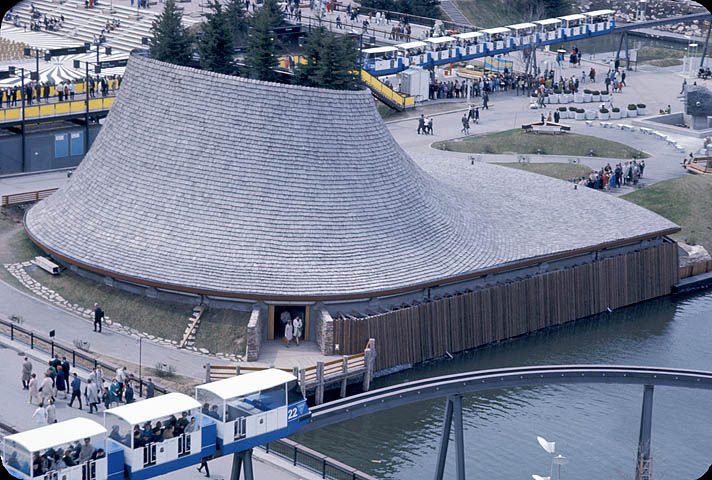

Photo credit: © National Archives of Canada
Pavilion of Western Canada
| Lofty Douglas firs rise above the
distinctive Pavilion of Western Canada, situated on Ile Notre-Dame with
the Pavilion of Canada and Québec as immediate neighbors and close to a
Minirail station.
The pavilion is virtually without walls and its irregular conical roof rests on low earthen embankments. It is finished in natural materials from Western Canada, and in the evenings lights along the lower edge of the pavilion create the impression that it is floating gently upon the shimmering waters of a canal. Its distinctive and highly original profile symbolizes the topography of the participating provinces of Manitoba, Saskatchewan, Alberta and British Columbia, from tree-decked mountain slopes to prairie and ocean. In nine "capsules" devoted to Western Canadian resources and their development, sound, sight and smell are brought into play to induce a real sense of participation in the spirit of Man and his World. The resources of industrial production, of agriculture and tourism, and above all of people, have their place. The resources of forest, mine, manufacturing and fishing, potash and agriculture, petroleum and electricity, food and people, are all introduced to visitors in the form of experiences. The outstanding impressions as the visitor passes through the nine distinct capsules in the pavilion will be of the 3,000-foot drop of a mine cage, and the overpowering sight of a giant, fully-loaded logging truck in its natural setting. The savory odor of vegetables cooking, the music of meadowlarks and rustling of grain in a summer breeze, the rhythmic chatter of mining drills and the crushing power evident in the mighty potash cutting heads, these are some of the elements that combine to add reality and fun to the presentations in their respective capsules. Look back a hundred years! In 1867 the great Hudson Bay Company still held sway over what are now the three Prairie provinces under the 1670 charter of King Charles II : three years later they were in Canada, with Manitoba a province since 1870 and Alberta and Saskatchewan since 1905. British Columbia became a province in 1871. And what a hundred years ago were perennial wastelands have become with mineral exploitation a major source of national wealth. Famed Western hospitality is the special quality of the Pavilion of the Western Provinces. Exhibits combine information and fun. The staff will be delighted to supply visitors with additional information about Western Canada. Click here to see a model to scale of the Pavilion of Western Canada. Click here to see photographs of the construction of the Pavilion of Western Canada. |
1/10